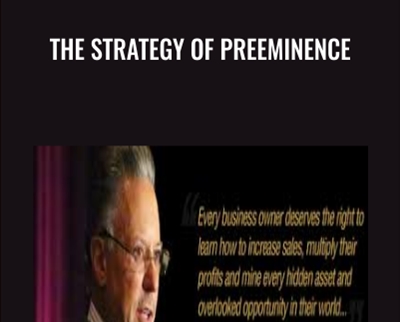The Strategy of Preeminence – Jay Abraham
Original price was: $24.00.$13.00Current price is: $13.00.
The Strategy of Preeminence – Jay Abraham Download. The Strategy of Preeminence (TSOP) is, hands-down, a preemptive business strategy to forge your activit…
Salepage link: At HERE. Archive:
The Strategy of Preeminence (TSOP) is, hands-down, a preemptive business strategy to forge your activities around. But it’s also a perfect selling template to teach all your sales people to use. Plus – it’s a tremendously effective tool – and a fail-proof formula for masterfully dealing with vendor and suppliers. As if that weren’t enough – TSOP is probably the first rule book I’ve discovered for building lasting, loving family relationships between husbands and wives, parents and children, individuals and friends.
TSOP, as I call is, is a disarmingly powerful business strategy that – when harnessed and executed properly – is virtually guaranteed to catapult any business – and most definitely “your specific business,” to lofty levels of multiplied results that will leave your competitors chocking on your dust.
The company I learned these principles from when from a mere $1,000 start-up investment to over $300 million in sales – leadership in their field, and a preeminent position that encures today in the minds and hearts of their customers – because of the certainty and authoritative posture they have been able to adopt in all their business endeavors.
The full blown explanation takes two intensive hours of my eX! Factor seminar. Here’s the short-course “primer” introductory version to get you started.
What Exactly is the Strategy of Preemience?
Preeminence extols, advocates, champions the role of the team member, supplier, prospect or customer
Its focus is on the receiver and their best interest. It boils down to, “I’m not trying to sell you – I want to serve you.”
How Do You Get Preeminence in a Market?
Preeminence is a multi-faceted approach like an integrated fabric. It’s a strategic mindset.
You get preeminence by subordinating your needs and totally focusing on the “other side” – the side of the client or the customer.
There are three groups of people you have to “sell”:
- Your fellow team member.
- Your suppliers.
- Your customers.
The Primary Basis for the Entire Preeminence Strategy is Based on a Keen Commitment to Empathy
Empathy is understanding in a very compassionate and respectful way how the “other side” in the transaction is feeling; how they see the situation (what their hopes, dreams, and needs are).
Truly preeminence companies and individuals, in every communication, always sell leadership; a definitive belief system, authoritative positioning, and a conviction of their point of view. They communicate in everything they do and say, that they want to lead you to a greater yield, a greater result, a greater happiness, or greater profit.
Preeminent companies make sure when they communicate with a customer or prospect that the customer senses that their feelings are understood.
It’s as if the company is saying, “I want to give you what you need, want, and deserve.”
There is a World of Difference Between Giving Information and Giving Helpful Advice
Information is inconclusive. Giving helpful advice is definitive; good advice is converted into action.
That’s why those who practice the strategy of preeminence tell people, “Here’s what you should do, here’s how you should do it and here’s why you should do it.” Being specific is incredibly powerful.
We have become people who are afraid to take a stand. But the people you trust are the people that help you come to a conclusion. People want you to be the expert!
When you truly care about your customers’ and clients’ well-being, you cannot allow that person to make a mistake, because your success depends on their success.
It’s Your Job to Help Provide Focus!
Focus is clarity
Focus: Most people don’t know what is out of focus until someone shows them. When they discover they’re “out of focus,” then they’ll want to make a decision to change. They don’t know they’re out of focus until they get into focus after you focus it for them.
Connect the dots for them. If you connect the dots, it helps them take a step. Once the dots are connected, people will go to the next step. That’s what “leading” is all about.
Clarity gives power
Clarity: It’s important for your customers to define for themselves their biggest frustrations, challenges, and opportunities. In most cases, they are paralyzed because they cannot put their dreams into words, and they just have a vague idea of what they really want so they can’t take action.
You want to give them clarity by asking them, “What would the picture look like if your business were operating the way you really want it to?”(Just asking this makes a change, in and of itself.)
You know, I often think that people in business are strikingly like people on a cross-county trip. They are in one of two places. They either know where they are but they have no idea of where they’re going. Or they know where they’re going but they have no idea where they are.
Power gives understanding
Understanding: The strategy of preeminence also depends on your ability and willingness to educate your customers and slients (and prospects) as to what their real options are.
Just telling people what to do and not telling them why they should do it doesn’t give them the confidence that going through the proves will produce.
Cultivate your ability to put into words that people want – and build on that.
The first thing is to articulate the biggest, clearest desired result people abstractly felt but never had clarified for them. They build a strategy of action they can take – new concepts they had never recognized they wanted before.
Understanding gives certainty
Certainty: Companies that practice the strategy of preeminence always come from a position of “hopefulness.” They genuinely have a better and higher wish or hopes for the client or prospect than they even had for themselves. The have the best wishes for every single prospect they come in contact with, even that person never does business with them in their life.
It is this hopefulness that gives their customers the courage, the belief, the strength, and the desire to establish a long-term, loyal, lifelong, relationship with that company.
Certainty gives trust
Trust: Always provide customers and prospects with views and viewpoints those customers can absolutely trust. Never put your interest ahead of your customer’s. Refuse to sell more or less of what they need. Always provide what is in your customer’s best interest.
Without trust, people won’t take action
Leadership: Most buyers base everything they do on absolute, authoritative leadership. Now condescension, but leadership. They want someone who they believe can lead them to great results, outcomes, joy, less pain, more profitability, more productivity. In fact, a true leader knows what’s possible and often times the customer doesn’t.
People silently think: “I don’t know what to do.” And they are searching for someone they trust, someone who understands their point of view, to point them in the right direction.
The fact is that people don’t trust “the system.” So leaders provide their customers with a viable alternative and perspective that gives the customer control and power.
People really are mad – they don’t feel anyone is listening to what they really want and they don’t know how to make anyone listen. This comes through in shoddy service, shoddy workmanship, shoddy products, and shoddy business practice.
You should go to someone like that and say, “I understand your frustration, and I think I can help. Here’s what I perceive you really want, and I’d like you to tell me first if that’s right or wrong. Once you and I agree that we both clearly and fully agree on your ultimate goals and dreams and wishes, then we can more forward with a plan to make them some true. And I think I can do that for you.” (But, you see, it all start with taking the customer’s point of view.)
Put yourself in their role. Understand where they’re at, what they’d probably do left to their own devices, and that they’d do it because they’d be emotionally frustrated and impetuous.
The strategy of Preeminence Relies on Authentic Communications
Always ask: Who are we communicating with? What problems are we going to help them deal with? How would we have the most positive impact on this person we are communicating with?
Remember: Your message doesn’t have any value unless it makes an impact. Information alone is not motivating. Unless it makes a positive and profound impact it doesn’t have any value.
People Buy for Emotional Benefits
Most people focus on tangible results, but most of the great rewards are tangible – like the birth of your first child, your college degree, winning the championship, or getting married. Typically, great rewards are emotional, not tangible. But most people sell on a tangible basis and ignore or forget about the emotions.
People have to recognize your advice as a solution to a problem they feel emotionally as well as rationally. Logic doesn’t make a sale. You have to compel people on the emotional level.
People will avoid making decisions because they don’t want to feel foolish. That’s another very powerful emotion. You don’t want them to feel fooling for what they are currently doing. But you want them to know there is a “better” way. Or maybe you can provide a better result or better feeling about what they are already doing.
You want to show how your product, your service, your friendship, your partnership, doing business with you will make people feel good about themselves.
Six Questions to Ask
- If I were on the receiving end, why would I want this?
- Why would I want to take advantage of this offer at this particular time?
- What’s in it for me?
- How will this product make me feel better about myself, my family, my business, my future, my life?
- Why is this better than doing what I’m doing – or doing nothing at all?
- So what?
Your promotion, your selling posture, your proposition has to answer a question that’s already on a customer’s mind. It has to provide a solution or a result that is big enough, tangible enough, and desirable enough that is will compel them to want to take action.
12 Words That Will Change Your Life Forever: “Most people fall in love with their product instead of their prospect.”
Of course, this is the exact reverse of what needs to happen to achieve the strategy of preeminence.
Most people think, “What so I have to say to get people to buy?”
Instead they should say, “What do I have to give? What benefit so I have to render?”
The message you want to give is: You matter. Your well-being is important to me.
To accomplish this, you have to believe your purpose is to contribute great value, not to take their money, but to give them a great outcome or result for what they are doing. You have to subordinate yourself and your interests and focus on them.
Sell the End Results, Not Steps to Get There
Typically, people say, “We’ve been very successful and we’d like to work with or for you.”
Instead says, “Let me show you what we do and how our systems works so you can sign on.”
People are searching for ways to make decisions better – they want ways to solve their problems today.
Most people don’t want to see things as a process. They’d rather see things as a project with a beginning and an end.
People don’t want to be average or have an average result or yield. People will relate to you when you respect them, empathize with them and genuinely tell them they don’t have to be average.
People need solutions not strategy. They need someone to advocate and address their well being.
Never be afraid to ask your current customers: “Is there a better way?”
The feeling in most ad agencies and consulting firms is that in order to sell people you have to “bedazzle” them with rhetoric when actually the opposite is true. A master of preeminence always wants to have ideas to leave their customers better off than when they started.
“Show Me” is More Powerful than “Tell Me”
Instead of making a conclusive statement, give ammunition that allows a person to come to their own conclusion. You never want to draw the conclusion for them – you want them to draw the conclusion and then take action that makes a commitment.
By allowing people to come to their own conclusions, not only do you get them to “buy into” your product and your service, but they will also “buy into” the end result they believe they will achieve. When they draw the conclusion that, “Yes, this really will make my life easier, or make me richer, or I’ll be more respected in my community, or more powerful in my business –” then they have begun to embrace the end result and they’ll have a much higher likelihood of actually reaching it.
Ways to Make It Easier for Them
Reduce the height of the hurdles. Lower the hurdles they have to jump over.
Talk about frustrations or desires they really feel.
People worry about whether they stand out, whether they’re unique, whether people will care – let them know you think they’re special, let them know you care.
Genuinely help them out – give your customers a chance to buy more often (don’t make them buy less then they want).
Most concepts are too difficult for most people to buy into the whole cloth on first blush – instead, give them an example of how things work.
Make the Customer the Center of Attention
If in the past your business has been “subject” focused, how can you make it “individual” focused?
Here are some tips to help you to communicate, write, think, and talk with a “them” focus rather than a “me” focus:
- Start each sentence with the word “you” rather than the word “I” or “me.”
- Talk about the end result in feelings, in emotional terms; what your product will bring, not how it will work.
- Ask your customers what they want.
- Listen to them!
Here's an overview of the prominent keywords and a list of famous authors:
Business and Sales: Explore business strategies, sales skills, entrepreneurship, and brand-building from authors like Joe Wicks, Jillian Michaels, and Tony Horton.
Sports and Fitness: Enhance athleticism, improve health and fitness with guidance from experts like Shaun T, Kayla Itsines, and Yoga with Adriene.
Personal Development: Develop communication skills, time management, creative thinking, and enhance self-awareness from authors like Gretchen Rubin, Simon Sinek, and Marie Kondo.
Technology and Coding: Learn about artificial intelligence, data analytics, programming, and blockchain technology from thought leaders like Neil deGrasse Tyson, Amy Cuddy, and Malcolm Gladwell.
Lifestyle and Wellness: Discover courses on holistic health, yoga, and healthy living from authors like Elizabeth Gilbert, Bill Nye, and Tracy Anderson.
Art and Creativity: Explore the world of art, creativity, and painting with guidance from renowned artists like Bob Ross and others.
All the courses on WSOlib are led by top authors and experts in their respective fields. Rest assured that the knowledge and skills you acquire are reliable and highly applicable.
Specification: The Strategy of Preeminence – Jay Abraham
|
User Reviews
Only logged in customers who have purchased this product may leave a review.

Original price was: $24.00.$13.00Current price is: $13.00.












There are no reviews yet.